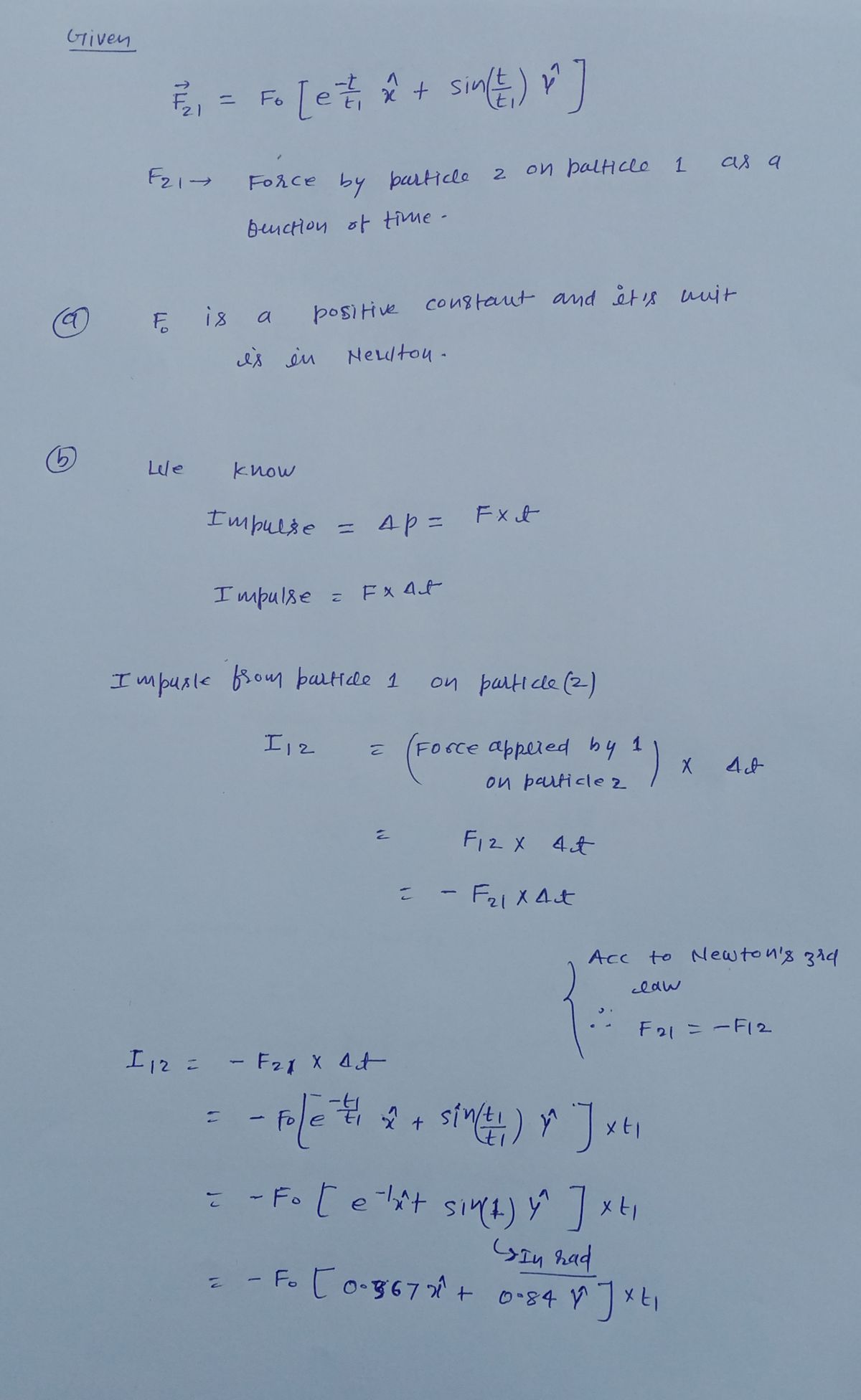Disclaimer: if this problem is chosen for the mini-exam, the given function may be different, but will be chosen from the exponential, trigonometric, or polynomial families. * There are two particles (1 and 2) that are moving around in space. The mass of particle 1 is m1 and the mass of particle 2 is m2. The particles are isolated so that only the forces between the particles are significant. The force that 2 exerts on 1 is given by: 2. F1(t) = Fo e î + sin where F, and t, are both constants. The particles interact with one another from t = 0 until t = t1. a. What is the physical meaning of F,? b. Find the impulse from particle 1 on particle 2 over this time interval. c. Find the impulse from particle 2 on particle 1 over this time interval. d. Find the change in momentum of particle 1 over this time interval. e. Find the change in momentum of particle 2 over this time interval. f. Find the change in momentum of the system that consists of particle 1 and particle 2 over this time interval.
Disclaimer: if this problem is chosen for the mini-exam, the given function may be different, but will be chosen from the exponential, trigonometric, or polynomial families. * There are two particles (1 and 2) that are moving around in space. The mass of particle 1 is m1 and the mass of particle 2 is m2. The particles are isolated so that only the forces between the particles are significant. The force that 2 exerts on 1 is given by: 2. F1(t) = Fo e î + sin where F, and t, are both constants. The particles interact with one another from t = 0 until t = t1. a. What is the physical meaning of F,? b. Find the impulse from particle 1 on particle 2 over this time interval. c. Find the impulse from particle 2 on particle 1 over this time interval. d. Find the change in momentum of particle 1 over this time interval. e. Find the change in momentum of particle 2 over this time interval. f. Find the change in momentum of the system that consists of particle 1 and particle 2 over this time interval.
Classical Dynamics of Particles and Systems
5th Edition
ISBN:9780534408961
Author:Stephen T. Thornton, Jerry B. Marion
Publisher:Stephen T. Thornton, Jerry B. Marion
Chapter9: Dynamics Of A System Of Particles
Section: Chapter Questions
Problem 9.17P
Related questions
Question

Transcribed Image Text:Disclaimer: if this problem is chosen for the mini-exam, the given function may be different, but will be
chosen from the exponential, trigonometric, or polynomial families. * There are two particles (1 and 2) that
are moving around in space. The mass of particle 1 is m1 and the mass of particle 2 is m2. The particles are
isolated so that only the forces between the particles are significant. The force that 2 exerts on 1 is given by:
2.
F1(t) = Fo e
î + sin
where F, and t, are both constants. The particles interact with one another from t = 0 until t = t1.
a. What is the physical meaning of F,?
b. Find the impulse from particle 1 on particle 2 over this time interval.
c. Find the impulse from particle 2 on particle 1 over this time interval.
d. Find the change in momentum of particle 1 over this time interval.
e. Find the change in momentum of particle 2 over this time interval.
f. Find the change in momentum of the system that consists of particle 1 and particle 2 over this time interval.
Expert Solution
Step 1

Trending now
This is a popular solution!
Step by step
Solved in 2 steps with 2 images

Knowledge Booster
Learn more about
Need a deep-dive on the concept behind this application? Look no further. Learn more about this topic, physics and related others by exploring similar questions and additional content below.Recommended textbooks for you

Classical Dynamics of Particles and Systems
Physics
ISBN:
9780534408961
Author:
Stephen T. Thornton, Jerry B. Marion
Publisher:
Cengage Learning

Classical Dynamics of Particles and Systems
Physics
ISBN:
9780534408961
Author:
Stephen T. Thornton, Jerry B. Marion
Publisher:
Cengage Learning